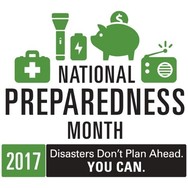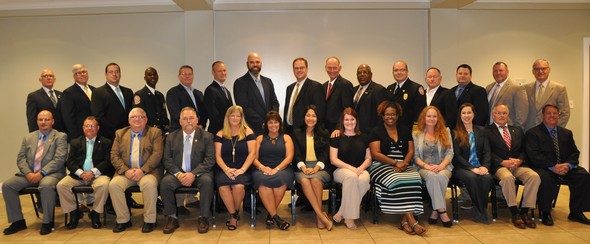|
The top priority of the U.S. Department of Homeland Security (DHS), FEMA, and its federal partners is to
support state, local, and tribal communities in Texas and Louisiana to protect the life and safety
of those in impacted areas.
Tropical Storm Harvey remains a dangerous, long duration storm. This storm
is hundreds of miles wide and is creating dangerous storm surge, flooding,
sustained winds and tornadoes. All those in the areas affected by Tropical Storm Harvey should continue to
follow the instructions of state, local, and tribal officials, including
instructions to shelter in place or evacuate. Do not return to evacuated areas
until told it is safe to do so. When it is safe, check on your neighbors who may require assistance, such as
infants, children, older adults, people with disabilities and others with
access and functional needs. Individual community members are the first line of
response following a storm.
Family and friends of those in the affected areas are urged to check social
network sites like Facebook or Twitter for information about your loved ones,
or use the American Red Cross’s Safe and Well program, to let family members know they are
safe, or looking for loved ones. To report a missing child, contact the National Center for Missing &
Exploited Children (NCMEC) at 1-866-908-9570. If your missing child has a
disability or access and functional need, please let NCMEC know when you
contact them. Anyone who finds an unaccompanied child who may have been
separated from their parents or caregivers should contact the local police, or
enter basic information and/or a photo into the National
Center for Missing & Exploited Children's Unaccompanied Minors Registry.
The compassion of the American people is already evident in their response to
the destruction the storm has caused. People can help by visiting www.nvoad.org,
and donating or volunteering with the voluntary or charitable organization of
their choice, many of which are already in affected areas supporting survivors,
even as the rain and wind continue. There is a lot of
work that has been done but the recovery will be challenging, and the
help of the whole community is required.
For more information about Hurricane Harvey, including
resources deployed, imagery, and video footage go to: www.fema.gov/hurricane-harvey.
FEMA’s top priority is to
make sure all of the necessary resources are on hand to support states,
tribes, and territories in their efforts to carry out life-saving and
life-sustaining activities and to meet the immediate needs of disaster
survivors. FEMA is currently heavily
engaged in supporting the ongoing, life-saving efforts in response to the
catastrophic effects resulting from Hurricane Harvey. The costs of these efforts are quickly
drawing down the remaining balance in FEMA’s Disaster Relief Fund.
FEMA implemented Immediate
Needs Funding (INF) guidance in order to extend the remaining balance of the Disaster
Relief Fund (DRF) so that FEMA can continue its focus on response and urgent
recovery efforts without interruption. INF is intended to meet the
urgent needs of disaster survivors and will prioritize funding. There have been a number of times in the past
where the agency found it necessary to issue INF allocation funding guidance,
as a precautionary measure, to maintain an adequate DRF balance while awaiting
passage of appropriations legislation.
Immediate needs funding does
allow for the allocation of funds for Individual
Assistance, Public Assistance Categories A and B (debris removal and emergency
protective measures), technical assistance contract support for Public
Assistance Categories A and B activities, technical assistance contract support
for Individual Assistance manufactured housing support, state management costs,
mission assignments, and essential joint field office (JFO) operations.
The
limitation applies to specific disaster funding for permanent work (Public
Assistance Categories C-G) the Hazard Mitigation Grant Program, as well as DRF
surge and disaster support activities. Funding is not being eliminated
for projects in these categories, but merely delayed until additional
appropriations are available. Adhering to these guidelines is critical to ensure that FEMA is able to
continue ongoing and future response and recovery efforts.
FEMA Administrator Long
strongly believes in the importance of hearing external partners’ perspectives
to help FEMA improve the way business is done. Throughout the next few months,
FEMA is inviting its stakeholders and partners from across the whole community
to help shape the Fiscal Year 2018-2022 FEMA Strategic Plan. In an
effort to reach as many stakeholders and partners as possible, FEMA is
accepting feedback via IdeaScale – an
interactive, web-based application that allows idea sharing, collaboration and
engagement.
FEMA values the input and
diverse perspectives that stakeholders and partners bring to help inform this
process, the final product, and the agency's efforts.
FEMA is looking for input
and engagement on:
Simplifying Recovery
and Reducing Disaster Costs
- How can FEMA simplify
recovery programs and reduce disaster costs while ensuring accountability,
customer service, and fiscal stewardship?
Buying Down Risk
through Preparedness and Mitigation
- How should risk be calculated in awarding grants?
- What type of grants are
best suited for effectively reducing risk?
- How do we incentivize
more investment in preparedness/mitigation prior to a disaster (not only
federal investment)?
- How should the nation,
including but not limited to FEMA, train and credential a surge disaster
workforce ahead of major disasters?
- What are new ways to
think about a true culture of preparedness?
We value the input and diverse perspectives that
you bring to help inform this process, the final product, and our efforts. Our IdeaScale campaigns will be open until October 5, 2017. We look forward to your
ideas and suggestions.
 It’s important to know what disasters
could happen in your community and how to prepare for them. Emergencies can
happen any time, and all Americans should be prepared for disasters that could
affect them.
September is National Preparedness Month,
which serves as a reminder that we all must take action to prepare now and
throughout the year for the types of disasters that can happen where we live,
work and visit.
This year’s theme, “Disasters Don’t Plan
Ahead. You Can,” encourages everyone to make an emergency communication plan ahead of time, partner with their
neighbors and community, train to be citizen responders, and practice their preparedness. Each week in
September, we will offer simple, no-cost preparedness tips.
The National Preparedness Month weekly
themes provide many opportunities to get prepared before an emergency. For
more information, including a social media toolkit you can use on your social
media accounts, visit www.ready.gov/september.
Week 1: September 1 - 9
Make a Plan for
Yourself, Family and Friends
Week 2: September 10 -
16
Plan to Help Your
Neighbor and Community
Week 3: September 17 -
23
Practice and Build Out Your
Plans
Week 4: September 24 - 30
Get
Involved! Be a Part of Something Larger
September 15 is National Prepareathon Day when people and
communities across the nation take action to prepare for and protect themselves
against disasters. To find out more about year-round Prepareathon activities,
go to www.ready.gov/prepare.
|
FEMA
hosted the inaugural meeting of the National Advisory Council’s (NAC)
Integrated Public Alert and Warning System (IPAWS) Subcommittee on August 8-9,
2017 at the agency’s headquarters in Washington, D.C.
The
NAC advises the FEMA Administrator on all aspects of emergency management to
ensure input from and coordination with state, local, tribal, and territorial
governments, and the private sector on federal plans, programs, and strategies
for all hazards.
The
meeting was highly successful in framing and identifying themes to develop recommendations on how FEMA can provide timely and
effective warnings during natural disasters, acts of terrorism, and other
man-made disasters or threats to public safety.
FEMA
established the NAC IPAWS
Subcommittee
pursuant to the IPAWS Modernization Act of 2015 to make recommendations to the
NAC related to common alerting and warning protocols, standards, terminology,
and operating procedures for an integrated public alert and warning system.
The
Subcommittee is composed of 44 members: Thirty-one qualified individuals from
13 categories, eight Senior Federal Leaders (or their designees); and five
members from the NAC who volunteered to be on the
Subcommittee. Their next in-person meeting is scheduled for March, 2018.
FEMA announced today that
Administrator Brock Long appointed 12 new members and reappointed one
current member to serve three-year terms on FEMA’s National Advisory Council
(NAC). Administrator Long also selected
Mike Sprayberry, Director of the North Carolina Division of Emergency
Management, to serve as the Vice Chair of the NAC, alongside NAC Chair Jim
Featherstone.
The NAC advises the FEMA
Administrator on all aspects of emergency management to ensure input from and
coordination with state, local, and tribal governments, and the private sector
on federal plans, programs, and strategies for all hazards. Members include a
geographically diverse and substantive cross-section of 35 officials, emergency
managers, and emergency responders from government and the private sector who
serve one or more three-year terms at the pleasure of the Administrator.
Approximately one-third of member terms end each year.
During the open application period from February
1 to March 15, 2017, FEMA received more than 170 membership applications to
fill the 13 open positions and carefully considered the qualifications of each
candidate. Administrator Long made the final selections.
FEMA congratulates 28 students who
graduated from the National
Emergency Management Advanced Academy hosted by the State of Florida on August
18. This course is the first regional delivery of the Advanced Academy in
Florida. Graduates represented emergency management professionals from state
and local governments, private sector, first responders, and academic
institutions.
The
week-long course culminated in a panel discussion with top emergency managers, Director of
the Florida Division
of Emergency Management,
Bryan
Koon, Emergency Management Institute’s
Superintendent, Tony Russell, and former FEMA Administrator Craig Fugate. Drawing from their years of experience in
emergency management, they engaged in a dynamic conversation with students
about their role in the field.
The Advanced Academy is designed for
mid-level managers seeking to advance their skills, and provides the strategic
level training and education essential for emergency management professionals
to effectively design, influence and lead cutting-edge programs. Students learn skills critical to
performing mid-manager responsibilities such as: program management and
oversight, effective communication at all levels, integrated collaboration, and
strategic thinking. The Advanced Academy provides students the opportunity to
demonstrate their critical thinking ability through a guided research project.
The Advanced Academy is the second of a three-level Academy series in the
Emergency Management Professional Program (EMPP).
The EMPP curriculum is designed to
guide and educate emergency management professionals as they progress through
their careers, providing a lifetime of learning. The EMPP includes three separate, but closely threaded training
programs – building from the Basic Academy, to the Advanced Academy, and culminating in the Executive Academy.
Visit www.training.fema.gov/empp for more information about EMPP.

FEMA Tribal Outreach and Consultation Period on FEMA Tribal Consultation Policy
FEMA initiated a 90-day outreach and consultation period
from June 1 to August 29, 2017, to seek input from federally recognized Indian
tribal governments on the update of FEMA's Tribal Consultation
Policy. First issued in 2014, the policy acknowledges the agency’s
nation-to-nation relationship with tribal governments. The policy also guides how FEMA
engages tribal governments in regular and meaningful consultation and
collaboration on policy and actions that have tribal implications.
Tribal officials can submit
comments on the FEMA Tribal Consultation until August 29, 2017,
through:
- E-mail to tribalconsultation@fema.dhs.gov, or
- Mail to ATTN: Margeau Valteau, Office of External Affairs,
DHS/FEMA, 500 C Street SW, Washington, DC 20472-3191.
Visit FEMA’s Tribal Affairs
web page for more information on the tribal consultation period for this
policy.
|